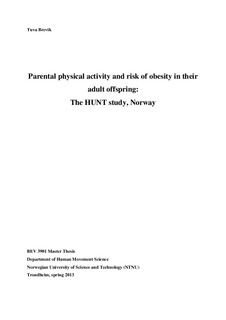| dc.contributor.advisor | Nilsen, Tom Ivar Lund | nb_NO |
| dc.contributor.advisor | Vik, Kirsti Lund | nb_NO |
| dc.contributor.author | Brevik, Tuva | nb_NO |
| dc.date.accessioned | 2014-12-19T14:44:36Z | |
| dc.date.available | 2014-12-19T14:44:36Z | |
| dc.date.created | 2013-08-19 | nb_NO |
| dc.date.issued | 2013 | nb_NO |
| dc.identifier | 641660 | nb_NO |
| dc.identifier.uri | http://hdl.handle.net/11250/271566 | |
| dc.description.abstract | Background: The occurrence of adiposity has increased in recent decades, and the detrimental consequences of obesity on health and disease constitutes a major challenge for public health. Parental obesity is a strong determinant of offspring obesity. This is in part due to genetic influences, but also environmental factors are of importance. Physical activity is a consistent and robust indicator associated with good health and reduced mortality, and a significant familial influence has been found linked to exercise participation. An association between parents’ health behaviors and body mass index (BMI) in offspring has also been reported. The aim of this study was to examine parental physical activity habits in relation to BMI and risk of obesity in their adult offspring.
Methods: The study was based on data from 18493 father-offspring pairs and 17885 mother-offspring pairs who attended at least one of the two latest waves of the Nord-Trøndelag Health Study (HUNT 2 and HUNT 3). Height and weight were measured, and participants completed a detailed questionnaire including questions on physical activity. Mean differences in offspring BMI were estimated between categories of parental physical activity using a general linear model, and logistic regression was used to calculate odds ratio (OR) for offspring obesity (BMI ≥30 kg/m2) associated with parental physical activity.
Results: Offspring with physically active parents showed lower mean BMI and lower risk of obesity in adulthood than offspring with less active or inactive parents. A statistically significant dose-response -relation between parental level of physical activity and risk of obesity in offspring showed that the association strengthened with increasing parental physical activity level. Mothers had a slightly stronger association with offspring than fathers. In relation to fathers and mothers high level of physical activity, the adjusted OR (95 % confidence interval) for offspring obesity was 0.76 (0.66 to 0.89) and 0.64 (0.54 to 0.76) compared to physically inactive parents.
Conclusion: In this population-based family linkage study, we found an inverse association between parental physical activity and offspring BMI for all measures of physical activity. Offspring of parents who were physically active had a lower risk of obesity than offspring of parents who were less active or inactive, and this was shown by a significant dose-response relation. The mother-offspring association was slightly stronger than the father-offspring association. | nb_NO |
| dc.language | eng | nb_NO |
| dc.publisher | Norges teknisk-naturvitenskapelige universitet, Fakultet for samfunnsvitenskap og teknologiledelse, Institutt for bevegelsesvitenskap | nb_NO |
| dc.title | Parental physical activity and risk of obesity in their adult offspring: The HUNT study, Norway | nb_NO |
| dc.type | Master thesis | nb_NO |
| dc.contributor.department | Norges teknisk-naturvitenskapelige universitet, Fakultet for samfunnsvitenskap og teknologiledelse, Institutt for bevegelsesvitenskap | nb_NO |
